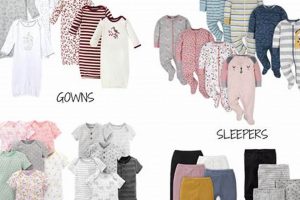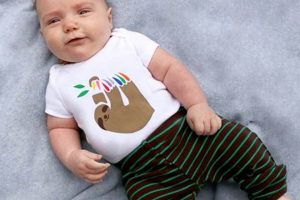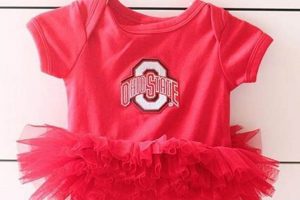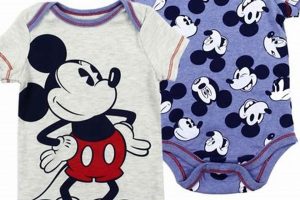High-fashion garments designed for infants and toddlers represent a niche market within the apparel industry. These items are characterized by the use of premium fabrics, intricate detailing, and meticulous construction techniques often associated with adult designer clothing. Examples include hand-embroidered dresses, cashmere sweaters, and miniature versions of classic designer outfits.
The significance of investing in such apparel stems from several factors. They provide superior comfort and durability due to the quality of materials used. Furthermore, these garments often become cherished keepsakes, passed down through generations. Historically, handcrafted clothing for infants signified a family’s status and attention to detail, a tradition that continues to resonate within this specialized market.
The subsequent sections will delve into specific aspects of this market, including the materials commonly employed, the design elements that distinguish it, and the ethical considerations associated with its production and consumption. Furthermore, the challenges and opportunities faced by designers operating in this specialized sector will be explored.
Essential Considerations for Selecting High-End Infant Apparel
Careful deliberation is required when acquiring specialized garments for young children. Prioritizing comfort, safety, and enduring value ensures a worthwhile investment. The following guidelines offer practical advice for informed decision-making.
Tip 1: Prioritize Natural and Hypoallergenic Fabrics: Opt for materials such as organic cotton, merino wool, or silk. These fibers are less likely to irritate delicate skin and offer enhanced breathability, promoting comfort and well-being.
Tip 2: Scrutinize Construction Quality: Examine seams, closures, and embellishments for secure attachment and smooth finish. Avoid items with loose buttons, exposed zippers, or abrasive trims that could pose a hazard.
Tip 3: Assess Garment Functionality: Choose designs that facilitate easy dressing and diaper changes. Features such as snap closures, expandable necklines, and adjustable waistbands enhance convenience and practicality.
Tip 4: Consider Garment Longevity: Select classic styles and durable fabrics that can withstand repeated wear and washing. Investing in timeless pieces allows for extended use and potential resale value.
Tip 5: Verify Ethical Production Practices: Seek brands committed to fair labor standards and sustainable manufacturing processes. Supporting companies that prioritize ethical sourcing and environmental responsibility contributes to a more conscientious industry.
Tip 6: Pay Attention to Sizing and Fit: Consult size charts and consider the child’s growth rate when selecting appropriate sizes. Allow for adequate room for movement and comfort, avoiding excessively tight or restrictive garments.
Tip 7: Research Care Instructions: Adhere to recommended washing and drying guidelines to maintain the garment’s appearance and prolong its lifespan. Proper care ensures lasting quality and minimizes the risk of damage or shrinkage.
By adhering to these guidelines, discerning consumers can ensure that high-end infant apparel provides both aesthetic appeal and practical benefits. Careful selection contributes to a child’s comfort, safety, and well-being while supporting responsible manufacturing practices.
The final section will summarize the key points discussed and offer concluding thoughts on the enduring appeal of these specialized garments.
1. Exquisite Fabrics
The selection of materials is paramount in distinguishing high-fashion infant apparel from mass-produced alternatives. The utilization of superior textiles directly influences the comfort, durability, and aesthetic appeal of garments designed for delicate skin.
- Natural Fiber Superiority
Fabrics such as organic cotton, merino wool, and silk are favored for their inherent softness and breathability. Organic cotton, cultivated without synthetic pesticides or fertilizers, minimizes the risk of skin irritation. Merino wool’s fine fibers provide warmth without bulk, while silk offers a luxurious drape and smooth texture. These natural fibers contribute to a garment’s overall comfort and suitability for sensitive skin.
- Yarn Quality and Weave Density
The quality of the yarn itself, as well as the density of the weave, significantly impacts the fabric’s performance. High-count yarns create a smoother, more durable fabric that is less prone to pilling or snagging. Tightly woven fabrics offer increased resistance to wear and tear, ensuring longevity even with frequent washing and use. The superior construction contributes to the garment’s ability to maintain its appearance over time.
- Dyeing and Finishing Processes
The processes used to dye and finish fabrics are crucial for ensuring safety and environmental responsibility. Low-impact dyes, free from harmful chemicals, minimize the risk of allergic reactions. Natural finishes, such as enzyme washes or botanical softeners, enhance the fabric’s texture without compromising its integrity. Sustainable and non-toxic finishing techniques demonstrate a commitment to both child welfare and environmental protection.
- Handcrafted Textiles and Embellishments
The incorporation of handcrafted textiles, such as hand-embroidered details or hand-woven accents, elevates the aesthetic value of the garment. These artisanal elements represent a significant investment of time and skill, distinguishing the item from mass-produced alternatives. The use of hand-applied embellishments, like delicate lace or mother-of-pearl buttons, adds a touch of uniqueness and exclusivity.
The deliberate selection and skillful manipulation of exquisite fabrics are central to the creation of high-fashion infant apparel. These materials not only enhance the garment’s aesthetic appeal but also contribute to its comfort, durability, and overall value. The commitment to using superior textiles reflects a dedication to quality and a consideration for the well-being of the child wearing the garment.
2. Intricate Details
The incorporation of intricate details distinguishes high-end infant apparel, elevating these items beyond basic functionality to objects of artistry and meticulous craftsmanship. These embellishments require specialized skills and contribute significantly to the garment’s overall aesthetic and perceived value.
- Hand Embroidery and Needlework
Hand embroidery, employing techniques such as French knots, satin stitch, and delicate appliqu, adds textural depth and visual interest to infant clothing. Examples include floral motifs on christening gowns or intricate animal designs adorning cashmere sweaters. The precision and time investment associated with hand embroidery elevate the perceived value and heirloom quality of the garment.
- Lace and Trims
The application of fine laces, such as Valenciennes or Chantilly, and meticulously crafted trims enhances the visual appeal of high-end infant apparel. These elements, often sourced from specialized suppliers, are strategically placed to accentuate design lines and create a sense of elegance. The delicate nature of these materials necessitates careful handling and specialized sewing techniques.
- Buttoning and Fasteners
Beyond basic functionality, the choice of buttons and fasteners in couture infant clothing contributes to the overall aesthetic. Mother-of-pearl buttons, hand-covered snaps, and delicate ribbon ties are frequently employed to create a sense of refinement. These details require precise placement and secure attachment to ensure both durability and visual appeal.
- Smocking and Pleating
Smocking and pleating are intricate fabric manipulation techniques used to create textural interest and visual complexity in infant garments. These techniques, often employed in dresses and blouses, require specialized equipment and skilled craftsmanship. The resulting garments possess a unique character and a sense of timeless elegance.
The presence of these intricate details underscores the commitment to quality and craftsmanship inherent in high-fashion infant apparel. They transform functional garments into cherished objects, reflecting a dedication to artistry and a pursuit of aesthetic excellence. The value placed on these details resonates with consumers seeking unique and enduring pieces for their children.
3. Handcrafted Elements
The presence of handcrafted elements forms a cornerstone of couture baby clothes, establishing a direct correlation between artisanal skill and elevated garment quality. The manual application of techniques such as embroidery, lacework, and hand-sewing inherently imbues each piece with a uniqueness unattainable through automated manufacturing processes. This deliberate human touch enhances not only the aesthetic appeal but also the intrinsic value of the apparel. For instance, a hand-embroidered christening gown, meticulously crafted over several weeks, embodies a level of care and dedication that transcends the purely functional purpose of clothing, transforming it into a potential heirloom.
The significance of handcrafted elements extends beyond mere visual enhancement. The selection and precise application of delicate materials, such as antique lace or hand-dyed silk ribbons, require specialized knowledge and a deep understanding of textile properties. This expertise ensures that the finished garment not only looks exquisite but also provides a comfortable and safe experience for the infant. The process also allows for greater customization and attention to detail, accommodating specific client requests or adapting designs to suit individual preferences. Consider the hand-stitched seams in a cashmere sweater, which, unlike machine-sewn seams, can be adjusted for a smoother fit and greater durability.
The inclusion of handcrafted elements in couture baby clothes presents both opportunities and challenges. While it allows for unparalleled levels of artistry and personalization, it also demands a significant investment of time and resources, resulting in higher production costs. Furthermore, maintaining consistent quality across handcrafted pieces requires a skilled and experienced workforce. Nevertheless, the enduring appeal of handcrafted goods, rooted in their unique character and inherent quality, continues to drive demand for couture baby clothes that showcase the artistry of skilled artisans, solidifying their position as highly sought-after items.
4. Limited Availability
The scarcity inherent in couture baby clothes is a defining characteristic, contributing significantly to their perceived value and exclusivity. Restricted production runs and selective distribution channels reinforce this perception, influencing both consumer demand and the market dynamics of this specialized sector.
- Exclusive Production Runs
Couture baby clothes are often produced in limited quantities, reflecting the time-intensive nature of their creation and the emphasis on handcrafted details. Designer collections may feature numbered editions or unique variations within a single style, further enhancing their collectibility. The deliberate limitation on production fosters a sense of rarity, driving demand among discerning consumers.
- Selective Retail Channels
Distribution of these garments is typically restricted to high-end boutiques, department stores with exclusive designer sections, or direct sales through the designer’s own channels. This selective placement ensures that the brand’s image remains consistent with its positioning and target demographic. The limited accessibility reinforces the perception of exclusivity, influencing consumer purchasing decisions.
- Bespoke and Custom Orders
The option for bespoke or custom-made garments further contributes to the limited availability. Clients can commission unique pieces tailored to their specific preferences, resulting in one-of-a-kind creations. This personalized approach caters to individuals seeking unparalleled exclusivity and a direct relationship with the designer.
- Seasonal Collections and Discontinued Lines
Couture brands often release seasonal collections, further restricting the availability of specific designs. Once a collection is discontinued, the garments become increasingly rare and potentially more valuable. This cycle of creation and obsolescence fuels the demand for past season pieces among collectors and enthusiasts.
The inherent scarcity of couture baby clothes, arising from exclusive production, selective distribution, and bespoke options, significantly shapes their market dynamics. This limited availability reinforces the perception of exclusivity and desirability, influencing consumer behavior and contributing to the garments’ overall value proposition.
5. Heirloom potential
The heirloom potential of couture baby clothes represents a significant consideration for discerning purchasers. These garments, owing to their superior materials and construction, are often viewed as investments intended for future generations, transcending the typical lifespan of children’s apparel.
- Enduring Material Quality
The selection of high-grade, natural fibers, such as organic cotton, cashmere, and silk, contributes directly to a garment’s longevity. These materials resist degradation more effectively than synthetic alternatives, ensuring the item retains its integrity and aesthetic appeal over extended periods. Properly maintained, a couture christening gown constructed from fine linen, for example, can withstand the test of time, becoming a tangible link to familial history.
- Robust Construction Techniques
Meticulous sewing methods, reinforced seams, and durable embellishments are hallmarks of couture garment construction. Hand-finishing and attention to detail minimize the risk of wear and tear, enhancing the garment’s ability to withstand repeated use and storage. A hand-knit baby blanket crafted with tightly spun yarn and reinforced edging, for instance, demonstrates the commitment to durability that contributes to its heirloom potential.
- Timeless Design Aesthetics
Couture baby clothes often feature classic, understated designs that transcend fleeting trends. Garments with enduring stylistic elements, such as simple A-line dresses or traditional sailor suits, remain relevant across generations, increasing their likelihood of being preserved and passed down. Avoiding overtly fashionable or character-themed designs contributes to a garment’s lasting appeal and heirloom status.
- Symbolic and Sentimental Value
Certain couture baby clothes acquire significance through association with important family milestones, such as christenings, birthdays, or significant cultural celebrations. These garments become imbued with memories and emotional value, transforming them into cherished keepsakes. A hand-embroidered dress worn by multiple generations during family gatherings, for example, embodies a powerful connection to the past, solidifying its heirloom status.
The enduring material quality, robust construction, timeless design aesthetics, and symbolic value of couture baby clothes converge to create a compelling case for their heirloom potential. These factors combine to elevate these garments beyond mere functional items, transforming them into tangible representations of family history and tradition.
6. Elevated Pricing
The elevated pricing associated with couture baby clothes is a direct consequence of several interconnected factors inherent in their production and market positioning. The use of superior materials, such as organic cotton, cashmere, and hand-selected silks, commands a higher cost than conventional textiles. Labor-intensive construction techniques, including hand embroidery, delicate lacework, and custom tailoring, further contribute to the increased expense. These production methodologies necessitate skilled artisans and a significantly longer manufacturing timeframe compared to mass-produced alternatives. The limited availability of these items, often produced in small batches or as bespoke commissions, amplifies their exclusivity and thus justifies a premium price point. Consider, for example, a hand-smocked dress using Swiss cotton, where the fabric alone can cost several times more than a similar garment constructed from a standard cotton blend, before accounting for labor.
The importance of elevated pricing extends beyond simply covering production costs. It serves as a crucial component of brand signaling, communicating the quality, exclusivity, and prestige associated with the couture label. A higher price point positions the brand within the luxury market segment, attracting consumers who value craftsmanship, uniqueness, and status. Moreover, the price acts as a barrier to entry, further solidifying the brand’s exclusivity and appeal to its target demographic. For instance, brands like Bonpoint or Tartine et Chocolat, known for their premium infant and children’s wear, utilize pricing to maintain their market position and attract customers willing to invest in quality and design.
Understanding the elevated pricing of couture baby clothes is practically significant for both consumers and businesses. Consumers can make informed purchasing decisions, weighing the cost against the perceived value in terms of quality, design, and heirloom potential. Businesses can leverage this understanding to effectively price their products, optimize production processes, and target the appropriate market segments. The challenge remains to balance the desire for exclusivity with the need for accessibility, ensuring that the brand’s pricing strategy aligns with its overall objectives and resonates with its target audience. The connection between elevated pricing and couture baby clothes underscores the complex interplay of material costs, labor, brand positioning, and consumer perception within the luxury apparel market.
Frequently Asked Questions
This section addresses common inquiries and clarifies misconceptions regarding high-fashion garments designed for infants and toddlers.
Question 1: What distinguishes couture baby clothes from standard infant apparel?
Couture baby clothes are characterized by the use of premium materials, intricate handwork, and limited production runs. Standard infant apparel typically employs mass-production techniques and lower-cost materials.
Question 2: Are couture baby clothes practical for everyday wear?
While possessing superior quality and aesthetic appeal, couture garments may not always be ideally suited for the rigors of daily wear. Their delicate nature and intricate embellishments often necessitate specialized care and handling.
Question 3: What factors contribute to the elevated pricing of couture baby clothes?
The high cost reflects the premium materials, skilled labor involved in handcrafting, limited availability, and brand positioning within the luxury market segment. The price premium also factors in the expectation of durability and heirloom potential.
Question 4: How should couture baby clothes be properly cared for?
Adherence to the garment’s specific care instructions is paramount. Hand washing with mild detergents, air drying, and professional cleaning are often recommended to preserve the integrity of the fabric and embellishments.
Question 5: What are the ethical considerations associated with purchasing couture baby clothes?
Consumers are encouraged to seek brands committed to fair labor practices and sustainable manufacturing processes. Verifying the origin of materials and the conditions under which the garments are produced ensures responsible consumption.
Question 6: Can couture baby clothes be considered an investment?
While primarily serving as apparel, certain couture garments, due to their rarity, craftsmanship, and heirloom potential, may appreciate in value over time. However, their primary purpose remains aesthetic and functional, not purely financial.
In summary, couture baby clothes represent a niche market driven by a demand for quality, craftsmanship, and exclusivity. Informed purchasing decisions should consider practicality, ethical sourcing, and proper care to maximize the garment’s value and lifespan.
The following section will explore future trends and innovations within the couture baby clothes industry.
Conclusion
This exploration of couture baby clothes has illuminated key aspects of this specialized market, from the utilization of exquisite fabrics and intricate detailing to the significance of limited availability and elevated pricing. The heirloom potential and ethical considerations inherent in these garments have also been examined, providing a comprehensive overview of the factors that define this niche within the apparel industry.
The enduring appeal of couture baby clothes lies in its fusion of artistry, quality, and exclusivity. As consumer awareness of sustainable and ethical practices grows, the future of this market hinges on the ability of designers and manufacturers to uphold these values while continuing to innovate and meet the evolving needs of discerning clientele. Further research into the long-term environmental impact and socio-economic implications of this sector remains crucial for ensuring its responsible and sustainable development.







